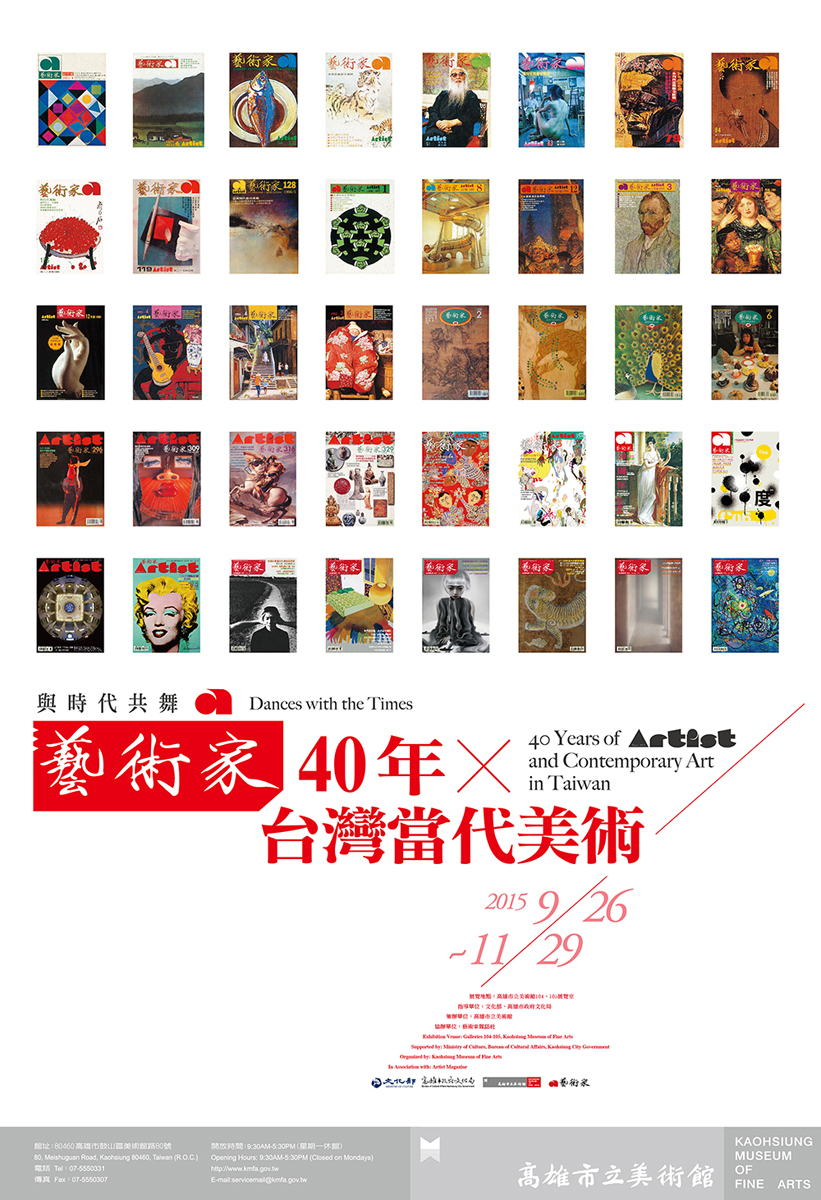Dances with the Times - 40 Years of Artists and Contemporary Art in Taiwan

DURATION: 2015-09-26 ~ 2015-12-06
OPENING: 2015-09-26
VENUE: Kaohsiung Museum of Fine Arts
In recent years, the Kaohsiung Museum of Fine Arts (KMFA) has curated and held several series of research-oriented exhibitions to review issues of Taiwan’s art history from different perspectives and guide viewers in their interpretations of the unique phenomena of Taiwan’s art development. These exhibitions of KMFA are based on its mission to establish itself as a museum that combines art and art history and provides alternative categorization methods for the discussions of Taiwan’s art history. Since 2013, KMFA has started a series of research-oriented exhibitions on the development of art ecosystems and organizations in Kaohsiung such as The Development of Art Galleries in Kaohsiung and Resonance of Heteroglossia—On the Modern Art Association of Kaohsiung. KMFA also started another series of research-oriented exhibitions to look at Taiwan’s contemporary art history from the development of domestic art magazines. The first exhibition of this series was The Era of “Lion Art” last year, an exhibition about Lion Art, one of the pioneering art magazines in Taiwan. This year, KMFA focuses on Artist, the art magazine with the longest publication history in Taiwan, and holds this exhibition to explore its contents and influence on Taiwan’s art development over the past four decades. No matter which series, these exhibitions of KMFA are all intended to provide diversified perspectives to look at Taiwan’s art history. A healthy and sound ecosystem of art depends on balanced and robust development of each component in the ecosystem. In addition to the artistic contributions of artists, also indispensable are the exhibitions held by art museums, galleries and art spaces, the dedication of art educators at all levels, and coverage by the media on the dynamics of art in different corners. In this new digital era of the 21st century, the trend of Internet-based media has definitely impacted the paper-based media such as newspapers and magazines. Amidst these challenges, Artist can still maintain its healthy and stable operation and stand out as the leading brand in the art magazine market in Taiwan. Launched in June 1975, Artist is a professional art magazine with the richest contents covering the widest aspects of art. Over the past four decades, the magazine has not won the hearts of many readers, witnessed the development of Taiwan’s contemporary art development, introduced the art development around the world to readers in Taiwan, but also dedicated itself to translating the difficult-to-understand rhetoric of art in a more understandable language for readers in Taiwan. An art magazine is more than a disseminator of information but an important carrier of art narratives. It plays a pivotal role in the art ecosystem. From an art magazine, we can read a segment of the art history. The curatorial concept of this exhibition is based on the“Southern Viewpoint on Taiwan’s Art”of KMFA complemented with the contents of Artist to represent and reconstruct the 40-year history of Taiwan’s art development. The contents of this exhibition come from KMFA, the Artist Magazine, and the History of Taiwan’s Contemporary Art—40 Years of Artist written mainly by Ni Tsai-chin, a late art critic. By combining artworks, texts (chronology and historical records), and video/audio materials, this exhibition aspires to give a concrete and detailed picture of 40 years of contemporary art development in Taiwan. Before his death, Mr. Ni was commissioned by the Artist Magazine to write the 20-year, 30-year and 40-year editions of History of Taiwan’s Contemporary Art. In these books, he used seven key frameworks to not only illustrate his views on this art magazine and Taiwan’s art development but also revisit the historical records and ecological development of Taiwan’s art world. One of the key frameworks was his selection of the “Work of the Year”—selection of a work most representative of Taiwan’s art development each year over the past decades. In this exhibition, all the “Works of the Year” are included and displayed together to give a full picture of the transitions of Taiwan’s art in terms of topics, media and expressional forms over the past 40 years. Considering the “Work of the Year” selection is probably tainted with Ni’s personal subjectivity, this exhibition also explores the social environment transitions that Artist has experienced. The magazine was established in June 1975, an era lacking in free information circulation before the lift of Martial Law. Then the magazine witnessed the frenzy after the lift of Martial Law, explosion of information amidst the rapid development of information technology, and now a new century of the Internet. In this exhibition, each of the four decades is explored individually in the following four sections based on the themes respectively of “Waves of Rural Art Movement (1975-1984)”, “Uproar and Frenzy before and after the Lift of Martial Law (1985-1994)”, “Digital‧New Era (1995-2004)” and “Cross-Discipline‧Zero Boundary (2005-2014)”. In each section, the representative “Works of the Year” of each decade are displayed, providing a chronological guideline for viewers. The display of these “Works of the Year” is like a time-lapse photographic work, epitomizing the changes and transitions of Taiwan’s art over the past four decades. The media, forms and rhetoric used by these “Works of the Year” are like connected dots that gives a clear picture of how Taiwan’s art and society have evolved over these years. It is indeed a worthwhile endeavor to research, represent and revisit all the data about Taiwan’s 40-year art development witnessed, recorded and accumulated by Artist since its first issue. Through this exhibition, viewers can have a time-lapse view of the trends and dynamics of Taiwan’s contemporary art over the past 40 years extracted from the historical data trove of the 480 issues of Artist.